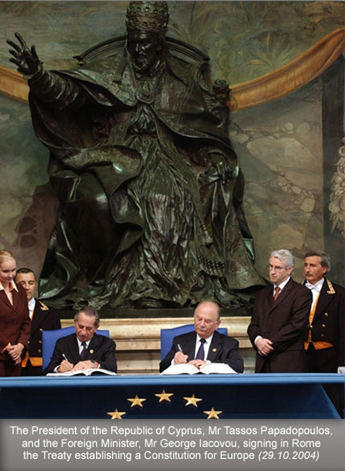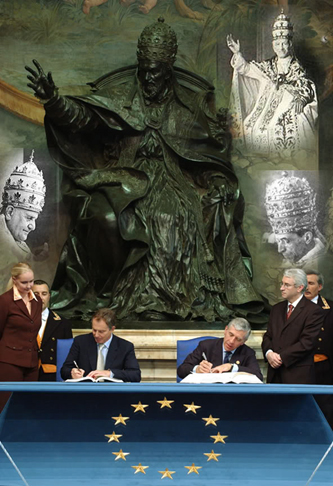
An Empire Established – Part 2
TimeWatch Editorial
June 29, 2016
Our last few editorials dealt with issues connected to the recent departure of Britain from the European Union. The gravity of the decision might have been lost, since it is not a well known fact that the Union itself is based upon a Constitution. As the United States of America is regulated by a Constitution, so is that Union of Europe. The Constitution is referred to as the Treaty establishing a Constitution for Europe as signed in Rome on 29 October 2004 and published in the Official Journal of the European Union on 16 December 2004. The original document itself consists of approximately 484 pages. The Preamble, yes, there is a preamble, expresses the motivation for the coming together of these nations:
“DRAWING INSPIRATION from the cultural, religious and humanist inheritance of Europe, from which have developed the universal values of the inviolable and inalienable rights of the human person, freedom, democracy, equality and the rule of law,… CONVINCED that, while remaining proud of their own national identities and history, the peoples of Europe are determined to transcend their former divisions and, united ever more closely, to forge a common destiny,… CONVINCED that, thus ‘United in diversity’, Europe offers them the best chance of pursuing, with due regard for the rights of each individual and in awareness of their responsibilities towards future generations and the Earth, the great venture which makes of it a special area of human hope, (we) have designated (the following persons) as our PLENIPOTENTIARIES (or representatives.)” Partial Preamble of the Treaty Establishing A Constitution For Europe
It must be made clear that the word plenipotentiary (from the Latin, plenus + potens, full + power) has two meanings. As a noun, it refers to a person who has "full powers." In particular, the term commonly refers to a diplomat fully authorized to represent a government as a prerogative, secondly As an adjective, plenipotentiary refers to something—an edict, assignment, etc.—that confers "full powers." It must be understood that this Constitution was signed in its original form by 27 Member States. Germany, United Kingdom, France, Italy, Spain, Poland, Romania, Netherlands, Greece, Czech Republic, Belgium, Hungary, Portugal, Sweden, Bulgaria, Austria, Slovakia, Denmark, Finland, Ireland, Lithuania, Latvia, Slovenia, Estonia, Cyprus, Luxembourg and Malta. The original number of representative seats in the European Parliament was 785, divided up of course nation by nation based upon each country’s population size.
What is also interesting is the fact that the signing of the Constitution took place October 29, 2004, in the Appartamento dei Conservatori, Sala degli Orazi e Curiazi, before the bronze statue of Pope Innocent X.
“The dignitaries were gathered in a room inside a palatial city hall and museum complex on Capitoline Hill. A marble statue of Julius Caesar dominated the room. A band played the "Ode to Joy" from Beethoven's Ninth Symphony. "For centuries, the story of Europe was one of enemies and their wars. It has become a story of friends and their partnership," declared the Netherlands' prime minister, Jan Peter Balkenende, after the gathering had moved to yet another Capitoline hall, this one featuring a monumental bust of the Emperor Constantine and a statue of Pope Innocent X. The selection of Rome as site of the signing ceremony was aimed at giving the event historical heft. Not only was Rome the center of Europe's first great stab at unity two millenniums ago, the city was also the site for the 1957 birth of the European Economic Community, forerunner of the E.U. Italy, Germany, France, Belgium, the Netherlands and Luxembourg signed the original Treaty of Rome.” Daniel Williams, “European Leaders Sign Constitution” The Washington Post, October 30, 2004
| The meaning is obvious. The location of the signing reveals the reverence and the oblation shown to the power that covers the signing. What is also revealing is the fact that the twelve stars of the European Flag represent the Catholic theology which claims Revelation 12 in its description of the woman standing upon the moon, clothed in the sun with twelve stars upon her head as Mary. |


With such theological connections, it will indeed be interesting to see how this European Union situation ultimately plays out.
Cameron A. Bowen







